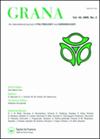Botanical and geographical origins of some commercial Apis mellifera var. adansonii honeys from Nigeria
IF 1
4区 生物学
Q4 PLANT SCIENCES
引用次数: 1
Abstract
Abstract In recent times, there has been an increase in adulterated honey in the commercial market owing to the lucrative nature of the honey business in Nigeria. Melissopalynology analyses can be used to obtain information about botanical and geographical origin of honey sources and to verify quality. Thus, this study was conducted to determine pollen composition and diversity in commercial honey samples from three states in Nigeria to ascertain their botanical and geographical origins. Seven commercial Apis mellifera var. adansonii honey samples were collected from three phytogeographical regions in Nigeria between 2017 and 2019. The samples were analysed for pollen content and other remaining structured elements occurring in sediment obtained using a non-acetolysed methodology. A total of 29 pollen types were identified, related to 18 families, 28 genera, and two unidentified pollen types. Fabaceae had the largest number of pollen types, followed by Asteraceae, Malvaceae, Arecaceae, Euphorbiaceae and Rubiaceae. Among the pollen identified, 22 pollen types were from nectariferous plants dominated by Dalbergia, Fagara/Zanthoxylum, Hymenocardia acida, Irvingia gabonensis, Macaranga, Nauclea latifolia and Pterocarpus. Monofloral honey of Nauclea latifolia and Pterocarpus sp. were also identified. The geographical origin demonstrates Apis mellifera var. adansonii using nectariferous sources available from the rainforest, forest-savanna ecotone, and Guinea savanna in the southeast, southwest, and central Nigeria, as well as in the brushwood, secondary forest, and open grassland areas, suggesting their importance as pollinators or pollen disperser agent of native flora and cultivated species.尼日利亚一些商业蜜蜂品种的植物学和地理起源
近年来,由于尼日利亚蜂蜜业务的利润丰厚,商业市场上掺假蜂蜜的数量有所增加。蜂蜜同源学分析可用于获取蜂蜜植物和地理来源的信息,并验证蜂蜜的质量。因此,本研究旨在确定来自尼日利亚三个州的商业蜂蜜样品的花粉组成和多样性,以确定其植物和地理来源。2017年至2019年期间,在尼日利亚的三个植物地理区域收集了7份商业阿达索尼蜜蜂蜂蜜样本。使用非乙酰化方法分析样品中的花粉含量和沉积物中其他剩余的结构元素。共鉴定出29种花粉类型,隶属于18科28属,2种未确定的花粉类型。豆科的花粉种类最多,其次是菊科、锦葵科、槟榔科、大戟科和茜草科。鉴定出的22种花粉类型均来自花蜜科植物,以黄檀属(Dalbergia)、Fagara/Zanthoxylum、Hymenocardia acida、Irvingia gabonensis、Macaranga、Nauclea latifolia和Pterocarpus为主。还鉴定出了Nauclea latifolia和Pterocarpus sp.的单花蜂蜜。地理来源表明,阿达索尼蜜蜂来自尼日利亚东南部、西南部和中部的热带雨林、森林-稀树草原过渡带和几内亚稀树草原,以及灌丛、次生林和开阔草原地区的蜜源,这表明它们作为本地植物和栽培物种的传粉者或花粉传播者的重要性。
本文章由计算机程序翻译,如有差异,请以英文原文为准。
求助全文
约1分钟内获得全文
求助全文
来源期刊

Grana
生物-植物科学
CiteScore
2.10
自引率
11.10%
发文量
23
审稿时长
>12 weeks
期刊介绍:
Grana is an international journal of palynology and aerobiology. It is published under the auspices of the Scandinavian Palynological Collegium (CPS) in affiliation with the International Association for Aerobiology (IAA). Grana publishes original papers, mainly on ontogony (morphology, and ultrastructure of pollen grains and spores of Eucaryota and their importance for plant taxonomy, ecology, phytogeography, paleobotany, etc.) and aerobiology. All submitted manuscripts are subject to initial appraisal by the Editors, and, if found suitable for further consideration, to peer review by independent, anonymous expert referees. All peer review is single blind and submission is online via ScholarOne Manuscripts.
 求助内容:
求助内容: 应助结果提醒方式:
应助结果提醒方式:


